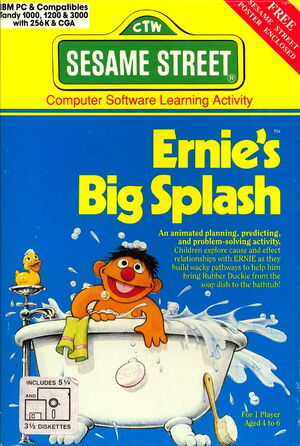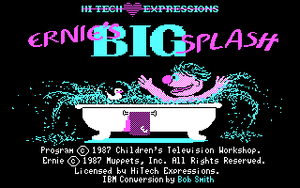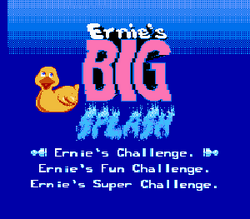BradFraggle (talk | contribs) mNo edit summary |
No edit summary |
||
| (16 intermediate revisions by 6 users not shown) | |||
| Line 1: | Line 1: | ||
| + | [[File:Hi_tech_1987_ernie's_big_splash_1.jpg|thumb|300px]] |
||
| ⚫ | |||
| − | [[Image: |
+ | [[Image:Ernies_Big_Splash_HiTech_Expressions.png|thumb|300px|Hi-Tech Expressions Version]] |
| ⚫ | '''''Ernie's Big Splash''''' is a 1986 ''[[Sesame Street]]'' video game starring [[Rubber Duckie (duck)|Rubber Duckie]]. The goal was to create a series of connections, for Rubber Duckie to make his way to [[Ernie]]'s bathtub. The game teaches basic logic, directions (North, South, East and West) and sequencing. |
||
| ⚫ | |||
| ⚫ | |||
| ⚫ | The game was originally made for DOS,<ref>[http://www.soapinthebathroom.com/articles/formatarticle.php?loc=http://soapinthebathroom.com/articles/ernie/ernie.html Soap in the Bathroom: Ernie's Big Splash]</ref> but was released for the [[:Category:Nintendo|Nintendo Entertainment System]] in 1989. On NES, it was released on the cartridge ''[[Sesame Street ABC]]'', supplementing ''[[Letter-Go-Round]]''.<ref>[http://cgi.ebay.com/Sesame-Street-Letter-Go-Round-Ernies-Big-Splash-NES_W0QQitemZ8189092683QQcategoryZ62053QQcmdZViewItem eBay: Sesame Street:Letter-Go-Round/ Ernie's Big Splash(NES)]</ref> At some point in time, the game was released for the [[wikipedia:Unisys ICON|Unisys ICON]] operating system, a platform commissioned by the [[Canada|Ontario]] education system. No copies of this format exist, as the last ICON computers and software were destroyed in the early-2000s. |
||
| ⚫ | |||
| − | |||
| ⚫ | |||
There is limited evidence that a version was released for [[Atari]] at a cost of $14.95, at the same time as ''[[Grover's Animal Adventures]]''.<ref>"[http://www.atarimagazines.com/compute/issue70/122_7_News_Products_Educational_Programs_For_Pre-School_High_School.php Educational Programs For Pre-School, High School]", ''Compute!'', March 1986, page 120.</ref> |
There is limited evidence that a version was released for [[Atari]] at a cost of $14.95, at the same time as ''[[Grover's Animal Adventures]]''.<ref>"[http://www.atarimagazines.com/compute/issue70/122_7_News_Products_Educational_Programs_For_Pre-School_High_School.php Educational Programs For Pre-School, High School]", ''Compute!'', March 1986, page 120.</ref> |
||
==Game play== |
==Game play== |
||
| + | ; Ernie's Challenge level |
||
| − | + | : ''The Rubber Duck will be shown in one square some where on the screen. Ernie will be in another square somewhere else of the screen. The object is to get the Rubber Duck over to Ernie. You do this by selecting which path you’d like to use, from a wide selection, to get there. Ex. Say that there are 3 squares all together, starting from the left and going right. The Rubber Duck is in square #1 and Ernie is in square #3. Now, you want to go to square #3, which is to the right. So, select a panel that will get you there. Each panel will have to arrows in it, one representing where you’re leaving from, one representing where you’re going. We want to go the right, so select the panel with two arrows pointing to the right. Hey, look! You made it to Ernie! This is actually a lot simpler than it looks, so don’t worry too much. Once you’ve made it to Ernie, a little song and dance will take place. After words, pressing the A button will repeat the little show, but in reverse. Pressing Start will start a new game.''<ref>Christopher Marsh, [http://72.14.207.104/search?q=cache:_Hz-tMY4TEgJ:www.neoseeker.com/redirector.php%3Furl%3Dhttp%253A%252F%252Ffaqs.neoseeker.com%252FGames%252FNES%252Fsesame_street_abc_123.txt%26k%3D1992+ernie%27s+big+splash&hl=en&ct=clnk&cd=3& Sesame Street: ABC/123 FAQ/Walkthrough], 2005. Google cache of walkthrough file.</ref> |
|
| − | ; Ernie's Fun Challenge |
+ | ; Ernie's Fun Challenge |
| − | + | : More path selections and more than one character on the screen. |
|
| + | ; Ernie's Super Challenge |
||
| + | : More path selections and more than one character on the screen. |
||
| + | <gallery widths=250px> |
||
| − | ==ROM hack of the game== |
||
| + | File:Hi_tech_1987_ernie's_big_splash_2.jpg |
||
| − | An R-rated "rom hack" of this game was created. I-Mockery.com reviewed the rom, and received a letter from Sesame Workshop in complaint.<ref>[www.i-mockery.com/romhacks/sesamestreet/ I-Mockery: Sesame Street]; warning this link contains relatively graphic images.</ref> |
||
| + | Image:Ernies_Big_Splash_HiTech_Expressions_2.png|Hi-Tech Expressions |
||
| ⚫ | |||
| + | Image:Sesame_Street_ABC_NES_SS6.png|Nintendo Version (as part of Sesame Street ABC Game) |
||
| + | </gallery> |
||
| − | == |
+ | ==Sources== |
<references /> |
<references /> |
||
| + | __NOWYSIWYG__ |
||
[[Category:Sesame Street Video Games]] |
[[Category:Sesame Street Video Games]] |
||
| + | [[Category:Hi Tech Expressions]] |
||
| + | [[Category:Nintendo]] |
||
Latest revision as of 06:53, 23 September 2018


Hi-Tech Expressions Version
Ernie's Big Splash is a 1986 Sesame Street video game starring Rubber Duckie. The goal was to create a series of connections, for Rubber Duckie to make his way to Ernie's bathtub. The game teaches basic logic, directions (North, South, East and West) and sequencing.
The video game was created by CBS Learning Systems, for ages four to six.
The game was originally made for DOS,[1] but was released for the Nintendo Entertainment System in 1989. On NES, it was released on the cartridge Sesame Street ABC, supplementing Letter-Go-Round.[2] At some point in time, the game was released for the Unisys ICON operating system, a platform commissioned by the Ontario education system. No copies of this format exist, as the last ICON computers and software were destroyed in the early-2000s.
There is limited evidence that a version was released for Atari at a cost of $14.95, at the same time as Grover's Animal Adventures.[3]
Game play
- Ernie's Challenge level
- The Rubber Duck will be shown in one square some where on the screen. Ernie will be in another square somewhere else of the screen. The object is to get the Rubber Duck over to Ernie. You do this by selecting which path you’d like to use, from a wide selection, to get there. Ex. Say that there are 3 squares all together, starting from the left and going right. The Rubber Duck is in square #1 and Ernie is in square #3. Now, you want to go to square #3, which is to the right. So, select a panel that will get you there. Each panel will have to arrows in it, one representing where you’re leaving from, one representing where you’re going. We want to go the right, so select the panel with two arrows pointing to the right. Hey, look! You made it to Ernie! This is actually a lot simpler than it looks, so don’t worry too much. Once you’ve made it to Ernie, a little song and dance will take place. After words, pressing the A button will repeat the little show, but in reverse. Pressing Start will start a new game.[4]
- Ernie's Fun Challenge
- More path selections and more than one character on the screen.
- Ernie's Super Challenge
- More path selections and more than one character on the screen.
Sources
- ↑ Soap in the Bathroom: Ernie's Big Splash
- ↑ eBay: Sesame Street:Letter-Go-Round/ Ernie's Big Splash(NES)
- ↑ "Educational Programs For Pre-School, High School", Compute!, March 1986, page 120.
- ↑ Christopher Marsh, Sesame Street: ABC/123 FAQ/Walkthrough, 2005. Google cache of walkthrough file.




